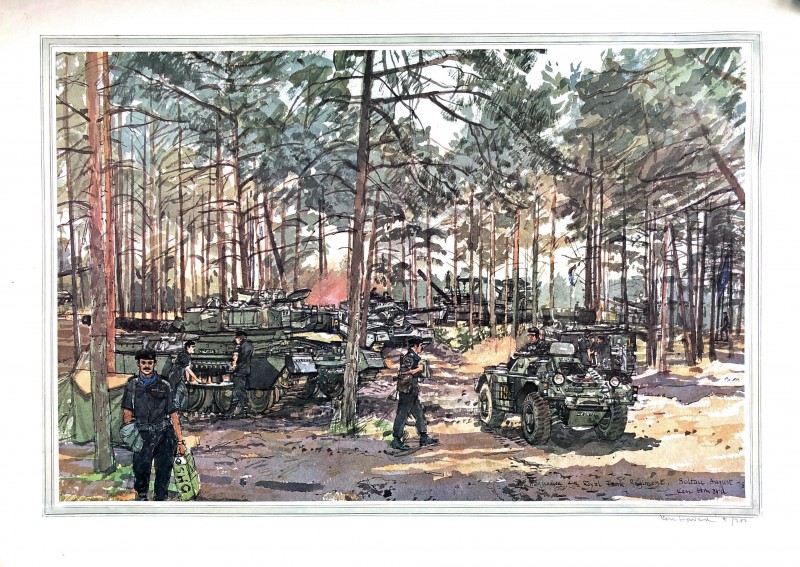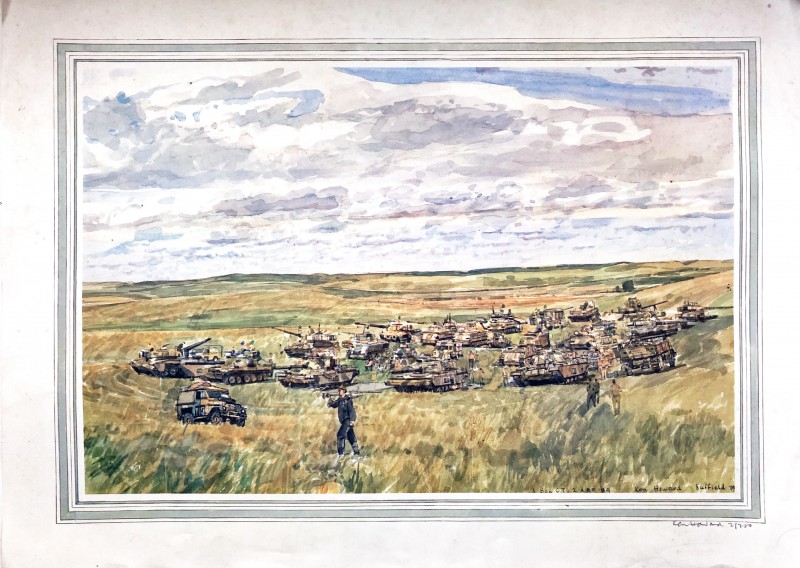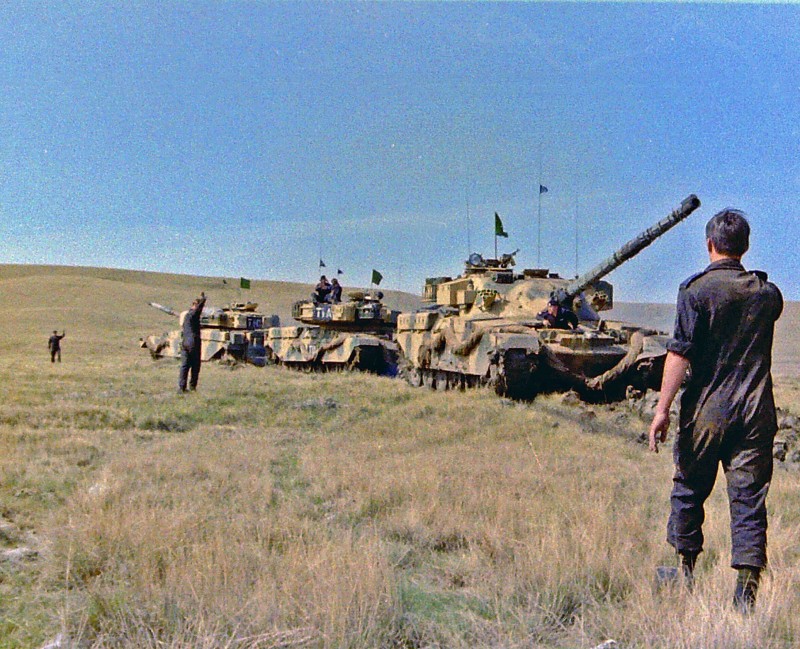Page 9 of 13
Re: Chinese Eye Chieftain
Posted: Thu Oct 24, 2019 9:48 pm
by Richard Goodwin
Stephen, would you be willing to share the dimensions of the jacking plates and the bottom access plates?
Many thanks
Re: Chinese Eye Chieftain
Posted: Wed Oct 30, 2019 7:03 pm
by Stephen White
Driver's drain plug OD 110mm
Jack plates 230mm
Belly access plate for fuel and oil tank drains: Width 360mm Length 290mm. Width to outside of mounting flange 460mm
Re: Chinese Eye Chieftain
Posted: Wed Oct 30, 2019 8:40 pm
by Stephen White
First task in assembling the hull bath tub is the triangular fillet plate at the rear. The geometry of this is fairly illusive, it's all about angles. It took some working out to establish the plane of the fillet plate, which then determines the shape, which I established on paper and then confirmed with a card template. The other aspect is the way in which the real plates are welded, which governs how the plates sit. A sketch spells it out.
Some preparatory work is needed, to mill a straight edge on the hull rear plate at the correct angle and then flatten the hull bottom plate and cut the necessary V. I also took the bottom plate to a local engineering shop, Hood Engineering in Warmwell, who couldn't have been more helpful, putting it into a whacking great brake press to increase the angle of the V from 3 to 5 deg. This then allows the angles of the V fillet to slot into place.
After machining the part, the next challenge is to hold it in place while I brazed the joints. I used brass rod pins, drilled through the fillet and bottom plate.
The aluminium brazing was not easy. It was important to hold the work pieces in the hull assembly because the angles are critical but this creates a problem of heat sink. There is simply so much metal that with a MAPP gas torch, it takes a while to get the work up to heat and for aluminium, that temperature is in a critically small range of 550 to 660 deg C. The top seam was OK but I found the heat needed for the bottom caused the hull bottom plate to sag a bit, which opened up the joint. If this all sounds like too much faff, it is but at least you end up with a strong hull and no fasteners. The result is pretty authentic but there is still work to do at the corners. I used the UV625 UV sensitive adhesive for the welds, to give additional strength but I'm not very happy with the effect and will add fabric paint to finish.
Re: Chinese Eye Chieftain
Posted: Wed Oct 30, 2019 8:58 pm
by Phil Woollard
That's a lot of work mate, I'm not sure yet but I know you will make it perfect!

You can see why I decided to compromise as the hull side plates now need your attention. Keep it coming!
Re: Chinese Eye Chieftain
Posted: Wed Oct 30, 2019 9:27 pm
by Richard Goodwin
Excellent effort Stephen, that's just how I remember it from the tank I saw on Sunday! I assume you will have sufficient clearance to mount the motors/gearboxes? I also note the nice unevenness of that cloth paint; I could do with that for my stillbrew! Keep up the good work!
Re: Chinese Eye Chieftain
Posted: Fri Nov 01, 2019 8:55 pm
by John Clarke
Fantastic work Stephen.................... (that bar gets higher and higher).
Looks like I'm gonna have to nip in the shed and get the old Black and Decker workmate out to do my bit of bending

I don't think there's too much to do with the side plates at the rear. I'd just like to get the belly plate flush with the side plates and loose that side plate overlap.
Here's a nice pair of exhausts, you can hardly see the side plates as they blend into the gearboxes.
Re: Chinese Eye Chieftain
Posted: Tue Nov 05, 2019 8:13 pm
by Stephen White
On with sorting out the basic geometry of the hull bath tub. I'll leave the final fit and details until I've got the heavy machining done.
The toe plate really sets the character of the front of the tank. You get two very different perceptions of the shape of the plate depending on whether your perspective is normal to the plane of the plate or parallel with the ground, since the plate sits at 45deg to the horizontal. This is the view horizontal to the ground:
Compare that with the perspective normal to the plane of the plate (ignoring the effect of each half being 3deg off the flat plane)
When compared with the kit part, you can see that there is a chamfer at the top which in reality is at the bottom. The hatched lines show the divergences. , some machining to do. This is also useful because it will secure the fit with the hull bottom plate which now has the correct 5deg V.
The part after machining top and bottom edges:
Fitted to the model, it all comes together. The weld at the bottom now conforms and the gap inside will be easily filled with UV glue.
The hull side plates now need some attention.
Re: Chinese Eye Chieftain
Posted: Tue Nov 05, 2019 8:50 pm
by John Clarke
If you keep this up Stephen I'm going to need an inhaler

Re: Chinese Eye Chieftain
Posted: Sat Nov 09, 2019 11:29 am
by Stephen White
In the 1970s, Professor Ken Howard OBE, the well known British artist and Royal Academician, did a lot of military work and became the official war artist for the British Army in Northern Ireland. He came to visit us in Belfast in 1978 and, liking the Fourth Tanks, asked if he could come back to paint us when we were back in Germany. He stayed with us as we re-built our tank skills on Soltau Training Area and particularly spent time with A Squadron, of which I was Second-in-Command at the time.

- A Squadron, 4th Royal Tank Regiment, Soltau, August 78 by Ken Howard OBE
Our Chieftains in Germany would still have been a mix of Mks 2 and 3, with perhaps some Mk 5s. This scene depicts a typical harbour area. It was painted during a maintenance period when the training was halted, probably at a weekend. Before anyone comments, this is a non-operational scene, hence the lack of camouflage, sentries etc. The earlier No 2 NBC pack is visible. There is a pack lift going on in the background, a very untypical activity for Chieftain.......
He then found his way to Canada the following year to re-visit A Squadron as we deployed onto the prairie as a "Combat Team" in support of 2nd Battalion Royal Regiment of Fusiliers Battle Group:

- A Squadron 4th Royal Tank Regiment, 2RRF BG, Suffield, 79
On the BATUS image, the 2IC's dozer tank is prominent in the first row. The scene depicts a typical tank leaguer, a drill first developed in the Western Desert in the 1940s. It is designed to provide the most effective all-round defence, with the more vulnerable vehicles in the centre. The columns were designed to make it easier to conduct logistics replenishment. Again, the scene is non-operational, painted on a maintenance day between exercises. A fully operational scene would make for a boring picture as all you would see would be camouflage.
Ken has a very wry sense of humour. In both paintings, he's added figures going about their business.... Relief in place on the top one (lone figure top right) and a figure in the foreground embarking on a shovel recce on the bottom. If you need to know what a shovel recce is, please don't PM me.
Re: Chinese Eye Chieftain
Posted: Sat Nov 09, 2019 11:43 am
by Kevin Hunter
Stephen White wrote: ↑Sat Nov 09, 2019 11:29 am
If you need to know what a shovel recce is, please don't PM me.
I suspect us civvies could hazard an educated guess.


Re: Chinese Eye Chieftain
Posted: Sat Nov 09, 2019 12:51 pm
by John Clarke
Must have been "Give Gofher's a break day"

Re: Chinese Eye Chieftain
Posted: Sat Nov 09, 2019 1:16 pm
by Chris Hall
Kevin Hunter wrote: ↑Sat Nov 09, 2019 11:43 am
Stephen White wrote: ↑Sat Nov 09, 2019 11:29 am
If you need to know what a shovel recce is, please don't PM me.
I suspect us civvies could hazard an educated guess.


One of my favourite WW2 war films is "Ice Cold in Alex", when Harry Andrews says something like "never ask a man with a spade where he's going"

.
Re: Chinese Eye Chieftain
Posted: Sat Nov 09, 2019 3:49 pm
by Mark Heaps
In germany, the shovel was to dig a hole.
My experience in Canada was use the shovel to fill in the gopher hole that you had just squatted over.
The gophers must have hated us.
Mark
Re: Chinese Eye Chieftain
Posted: Wed Nov 13, 2019 2:08 pm
by Stephen White
Phil mentioned bellying in, which of course never happened to the more switched on tank commanders....... as if. The REME ARV was the chosen option to recover a bogged tank but that cost the crew a slab at least for the Recce Mech (= recovery mechanic, the expert). If the ARV was otherwise occupied, or the crew commander was tight fisted, troop recovery was practised. It could turn into a very stately dance, which required very precise coordination if further damage was to be avoided. This photo shows one such effort. It shows squadron headquarters A Squadron, 4th Tanks in Canada with the 2nd Fusiliers Battlegroup. I'm sure our REME subject matter expert will have a view but usually the pull would be in a straight line. This pull at an angle was probably constrained by the area of boggy ground.

The ground in Canada was notoriously difficult to read and after a prairie storm, apparently firm ground could turn treacherous overnight. This could be used to your advantage. In 1995, I took 2nd Tanks to Canada to form the first OPFOR (ie professional enemy). We were equipped with visually modified CVR(T) which resembled T-64 and BMP and used tactics based on what we knew of Soviet drills. On one defensive battle, I deployed my battle group on the reverse slope of a ridgeline with minefields to channel the exercising battle group. To make sure they went the way I wanted them to go ie across a dry lake bed, we prepared the scene by driving several of our "tank" into the bog from the "enemy"direction, with the instruction "go like hell and see how far you can get". We then recovered them all to dry land on our side, completing the tracks across the bog. We then sat back and waited. The battlegroup duly attacked our forward screen, drove in the advanced guard and crested a small feature to see the clearly passable dry lake ahead and our defensive minefield on the forward slope ahead. They were very quick (too quick?) in launching their battlegroup attack, which resulted in more than a dozen of their vehicles becoming bogged, which effectively screwed the exercise. I was given some advice by the divisional commander along the lines of very clever but please play nicely, it's costing a lot of money to exercise the battlegroup and we can't afford to waste it practising recovery. Point taken. (But my lot considered it a victory anyway). Wish I had a photo. I hesitate to name the battlegroup but I can be persuaded to reveal all for a small donation to my favourite service charity.
Meanwhile, back on the model......
Re: Chinese Eye Chieftain
Posted: Thu Nov 14, 2019 12:30 am
by John Clarke
Super picture Stephen.

Most of the greatest victories on the battlefield have depended on terrain, usually of the victors choosing.
(Never give a sucker an even break).

